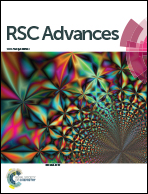Facile fabrication of porous BiVO4 hollow spheres with improved visible-light photocatalytic properties†
Abstract
Bismuth vanadate (BiVO4) hollow spheres with porous structure have been successfully fabricated by a one-step wet solution method with no surfactant and template. The structure, morphologies, and composition of the as-prepared products were studied with X-ray powder diffraction (XRD), transmission electron morphology (TEM), Brunauer–Emmett–Teller (BET), X-ray photoelectron spectroscopy (XPS) and UV-vis spectroscopy. Based upon the time-dependent experimental results, BiVO4 nanospheres with hollow and solid structures can be controlled effectively through the reaction time, and a reasonable formation process was suggested in this work. Moreover, the experiment of degrading methyl orange (MO) under visible-light illumination was conducted to evaluate the photocatalytic performance of the obtained BiVO4 samples. The porous BiVO4 hollow spheres exhibit superior visible-light photocatalytic properties for MO degradation than other photocatalysts under irradiation, and could be reused for up to five times without significant reduction in the photocatalytic activity. In addition, based on active group trapping experiments, ˙OH radicals as the main active species from H2O2 molecules play a vital role in the photocatalytic degradation of MO, and a photocatalytic mechanism for the BiVO4 system was proposed. High photocatalytic activity, universality and stability suggest that the porous BiVO4 hollow spheres may have potential applications in wastewater treatment.


 Please wait while we load your content...
Please wait while we load your content...